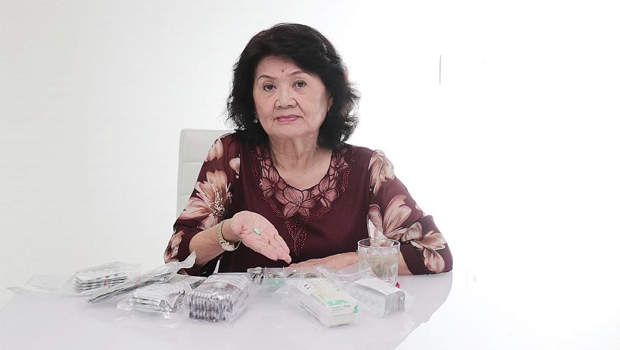
Madam Tan Choon Lan, 81, with the medication and supplements that she takes every day. She is among the many seniors in Singapore who find it difficult to understand prescription medication labels.ST PHOTO: KELVIN CHNG
Study looking into producing standardised pictograms, using languages besides English
Every day, Madam Tan Choon Lan takes six different kinds of medication and supplements, but she faces one major hurdle - she cannot read the labels that are written in English.
To get around this, she gets the pharmacist to explain the instructions in Mandarin, and writes them down when she gets home to make sure she remembers them.
"If it's the same medication, I won't forget, but I might if it's a new one, so I go back to the polyclinic to ask them again," said Madam Tan, 81, a retired broker who has high blood pressure and high cholesterol. She visits the polyclinic mostly on her own, and sometimes with her son.
Her problem is hardly unique as there are many among the elderly in Singapore who find it difficult to understand prescription medication labels.
Their struggles have prompted a local study to make these labels easier to understand for seniors, many of whom struggle with English and have poor eyesight.
 Led by researchers from Duke-NUS Medical School, the ongoing study, which started in 2017, has gathered feedback on the use of pictograms in labels from 250 polyclinic patients aged 60 and older who cannot read English.
Led by researchers from Duke-NUS Medical School, the ongoing study, which started in 2017, has gathered feedback on the use of pictograms in labels from 250 polyclinic patients aged 60 and older who cannot read English.
Researchers also interviewed pharmacists and pharmacy technicians from six polyclinics - under SingHealth Polyclinics and National Healthcare Group (NHG) Polyclinics - and from NHG Pharmacy. In addition, they interviewed caregivers who managed medication for their older family members.
Dr Tan Ngiap Chuan, director of research at SingHealth Polyclinics said some of the issues that trip up patients were already known to pharmacists - an inability to read English, a font size that is too small, and confusing pictograms.
Pharmacists have to spend extra time explaining the labels to these patients, printing labels in a different language or even rewriting the instructions on the label in larger handwriting, he added.
Assistant Professor Rahul Malhotra, head of research at Duke-NUS Medical School's Centre for Ageing Research and Education (Care), said: "All this takes away precious time from the actual medication counselling, (such as) discussing any drug interactions, and there is... limited time in the public system."
The study, called Prescription Medication Label Improvement for Singaporean Elderly (Promise), revealed other crucial insights.
For example, older Singaporeans with limited or no English reading ability need help from family members, foreign domestic workers and healthcare professionals to interpret labels.
Many respondents also said information on what medical condition the drug is prescribed for, the expiry date, side effects and precautions was sometimes unavailable on prescription medication labels, while some instructions, such as those on the frequency of dosage, were confusing.
An earlier study in 2015 by Care found that English literacy is not necessarily equal to English health literacy, said Prof Malhotra, who is lead researcher of the Promise study.
The study looked at 1,167 older Singaporeans who were taking at least one type of medication on a regular basis.
Of the approximate one-third of them, or 35.2 per cent, who were able to read English, only around a quarter, or 28.4 per cent, had satisfactory English health literacy.
"I think (in the future) it will be an issue that will not be as prominent as (it is) today, but it won't go away," said Prof Malhotra.
While NHG Polyclinics currently prints customised pictograms and multilingual labels for patients on request, researchers hope to produce a standardised set of prescription medication labels adapted from the International Pharmaceutical Federation's pictograms.
The team is also working with the National Institute of Education and the Children's Hospital of Eastern Ontario Research Institute to analyse participants' feedback.
So far, respondents have suggested that labels with pictograms and instructions that are not only in English would be useful.
Researchers aim to start interviewing, in January next year, another 600 polyclinic patients from the same age group - with and without English ability - to get their feedback on the revised pictograms and issues they face reading the labels.
When the study concludes next year, its findings will be presented to healthcare administrators and policymakers, including the Ministry of Health.
"It's not rocket science... but it's something that has been present and has direct impact on the life of a Singaporean," said Prof Malhotra, adding that easily understood labels will empower the elderly to take care of themselves.













 Get it on Google Play
Get it on Google Play